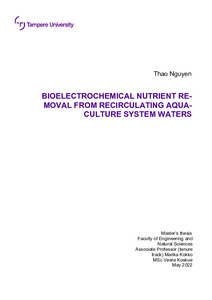Bioelectrochemical nutrient removal from recirculating aquaculture system waters
Nguyen, Thao (2022)
Nguyen, Thao
2022
Master's Programme in Environmental Engineering
Tekniikan ja luonnontieteiden tiedekunta - Faculty of Engineering and Natural Sciences
This publication is copyrighted. You may download, display and print it for Your own personal use. Commercial use is prohibited.
Hyväksymispäivämäärä
2022-05-20
Julkaisun pysyvä osoite on
https://urn.fi/URN:NBN:fi:tuni-202205104627
https://urn.fi/URN:NBN:fi:tuni-202205104627
Tiivistelmä
Recirculating aquaculture system (RAS) is a highly engineered aquaculture system which can operate independently of the local climate while maintaining high production capacity. However, fish cultured in RAS may accumulate distasteful off-flavor compounds (OFCs), which are removed by cleaning the fish with high volumes of water. OFCs have been found to be highly abundant in the aerobic biological filters employed in RAS for nitrification of ammonia. Therefore, utilizing alternative methods such as bioelectrochemical system (BES) for ammonium removal under anaerobic condition may mitigate the production of OFCs in RAS.
The main objective of the thesis was to determine the maximum total ammonia nitrogen (TAN) removal efficiency achievable with a BES configuration referred to as bioelectroconcentration cell (BEC) and evaluate its potential for application in RAS facilities. Additionally, the thesis contributed to the growing area of research on bioelectrochemical technologies, more specifically toward the capability of BES for nutrient removal from low strength wastewater streams.
In the experiment, anodic electroactive microorganisms were first enriched in the triplicate BEC reactor set-ups fed with synthetic RAS water containing more organics and buffers as found in typical freshwater RAS waters. The content of organics and buffers were gradually decreased over the course of enrichment period. As the microbial community had matured, the experiment progressed towards continuous phase, during which decreasing hydraulic retention times (HRTs) of 18.7 h, 13.6 h, and 9.8 h were tested to determine the optimal operational condition for TAN removal with the system.
During enrichment phase, the reactors progressed in a predictable manner and demonstrated capability for nitrogen removal under batch mode operation with maximum TAN removal efficiency of 81.7 ± 17.7%. During continuous phase, maximum TAN removal efficiency (33.5 ± 26.5 %) and TAN removal rate (5.7 ± 4.9 gN m-3 d-1) were achieved with the BEC set-ups at HRT of 18.7 h, while lower removal efficiencies were obtained with HRTs of 13.6 h (13.3 ± 4.2%) and 9.8 h (11.3 ± 5.9%), which suggested inverse relationship between TAN removal efficiency and HRT. The TAN removal rate was independent of the HRT as minimum TAN removal rate was achieved at HRT of 13.6 h. Although there was potential for TAN removal, the system requires further optimization to be comparable to the treatment efficiency demanded in RAS facilities. Additionally, due to the low electrical conductivity of RAS water, the TAN removal rates and efficiencies obtained in the experiment were also insignificant compared to most BEC set-ups previously described. Overall, the thesis served as a preliminary investigation of bioelectrochemical treatment of RAS waters.
The main objective of the thesis was to determine the maximum total ammonia nitrogen (TAN) removal efficiency achievable with a BES configuration referred to as bioelectroconcentration cell (BEC) and evaluate its potential for application in RAS facilities. Additionally, the thesis contributed to the growing area of research on bioelectrochemical technologies, more specifically toward the capability of BES for nutrient removal from low strength wastewater streams.
In the experiment, anodic electroactive microorganisms were first enriched in the triplicate BEC reactor set-ups fed with synthetic RAS water containing more organics and buffers as found in typical freshwater RAS waters. The content of organics and buffers were gradually decreased over the course of enrichment period. As the microbial community had matured, the experiment progressed towards continuous phase, during which decreasing hydraulic retention times (HRTs) of 18.7 h, 13.6 h, and 9.8 h were tested to determine the optimal operational condition for TAN removal with the system.
During enrichment phase, the reactors progressed in a predictable manner and demonstrated capability for nitrogen removal under batch mode operation with maximum TAN removal efficiency of 81.7 ± 17.7%. During continuous phase, maximum TAN removal efficiency (33.5 ± 26.5 %) and TAN removal rate (5.7 ± 4.9 gN m-3 d-1) were achieved with the BEC set-ups at HRT of 18.7 h, while lower removal efficiencies were obtained with HRTs of 13.6 h (13.3 ± 4.2%) and 9.8 h (11.3 ± 5.9%), which suggested inverse relationship between TAN removal efficiency and HRT. The TAN removal rate was independent of the HRT as minimum TAN removal rate was achieved at HRT of 13.6 h. Although there was potential for TAN removal, the system requires further optimization to be comparable to the treatment efficiency demanded in RAS facilities. Additionally, due to the low electrical conductivity of RAS water, the TAN removal rates and efficiencies obtained in the experiment were also insignificant compared to most BEC set-ups previously described. Overall, the thesis served as a preliminary investigation of bioelectrochemical treatment of RAS waters.
